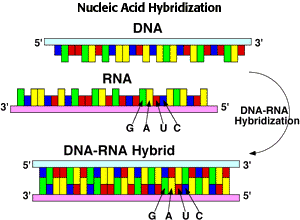
Molecular Genetics of Prokaryotes Problem Set
Problem 9: Hybridization of mRNA with the DNA coding strand
mRNA will form hybrids only with the coding strand of DNA because:Tutorial
|
An RNA molecule can form a base-paired DNA-RNA duplex molecule with a DNA that has complementary base pairing. The most common source of DNA complementary to an mRNA is the DNA coding strand that was the template for synthesis of the RNA. RNA-DNA hybridization follows the same base pairing rules as two complementary DNA strands. The two complementary strands have opposite polarity, i.e. a strand with 5' ==>> 3' direction pairs with a complementary strand of opposite direction, 3' ==>> 5'.
In DNA-RNA hybrid formation, G base pairs with C, A of the RNA pairs with T of the DNA, and U or the RNA pairs with A of the DNA. The DNA-RNA hybridization reaction is illustrated below: |

University of Arizona
Thursday, October 30, 1997
Contact the Development Team
http://www.biology.arizona.edu
All contents copyright © 1997. All rights reserved.






